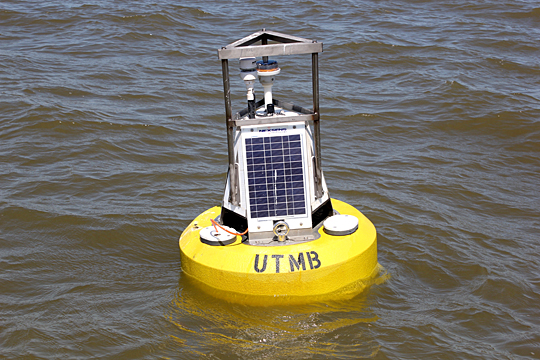For the second year in a row, The University of Toledo water quality and sensor buoy rides the waves off the shore of the Maumee Bay State Park Lodge and Conference Center in Oregon, Ohio.
It is part of a network of buoys throughout the western Lake Erie basin that provides live data vital in the assessment of harmful algal blooms.

The UT water quality and sensor buoy rides the waves off the shore of the Maumee Bay State Park Lodge in Oregon, Ohio.
The UT buoy is equipped with what is called the YSI EXO sonde, a black and blue instrument comprised of several probes to measure various water quality parameters, including how much blue-green algae is present, water temperature, clarity, oxygen levels, turbidity and pH.
“pH tells us a lot,” Bridgeman said. “When the pH goes up, it means the algae is growing really fast. As algae is growing, it’s sucking the CO2 out of the water causing the pH to rise.”

Dr. Thomas Bridgeman discussed UT’s buoy and his ongoing algae research during a press conference at the Collins Park Water Treatment Plant.
Earlier this month, Toledo city leaders invited Bridgeman to discuss UT’s recently deployed buoy and his ongoing algae research during a news conference at the Collins Park Water Treatment Plant. The event alerted the public to upgrades made at the plant and the revised Water Quality Dashboard that reflects the level of the toxin microcystin. This year the dashboard needle won’t move unless the concentration in raw lake water goes above five parts per billion or trace levels of toxin are detected in drinking water treated at the plant.
“Keeping our drinking water safe is truly a collaboration and partnership with academia and the Ohio EPA,” Toledo Mayor Paula Hicks-Hudson said.
Bridgeman told the media, city leaders and plant operators that UT graduate students will study the vertical distribution of algae over a 24-hour period in August during peak algal bloom season.
“Those students will sit in a boat and take measurements all day and all night long in order to study the movement of algal blooms,” Bridgeman said. “It’s kind of anecdotal right now, but toxic algae tends to come to the surface in the middle of the day. Since intakes are below the surface, that might be a good time to pump water to the plant. There is no definitive study as to what happens at night. We have a responsibility to provide practical answers.”